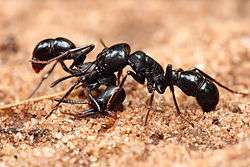Ponerinae
Ponerinae is a subfamily of ants in the Poneromorph subfamilies group, with about 1,600 species in 47 extant genera, including Dinoponera gigantea - one of the world's largest species of ant. Mated workers have replaced the queen as the functional egg-layers in several species of ponerine ants. In such queenless species, the reproductive status of workers can only be determined through ovarian dissections.
| Ponerinae | |
|---|---|
 | |
| Fighting Harpegnathos saltator | |
| Scientific classification | |
| Kingdom: | Animalia |
| Phylum: | Arthropoda |
| Class: | Insecta |
| Order: | Hymenoptera |
| Family: | Formicidae |
| Subfamily: | Ponerinae Lepeletier, 1835 |
| Type genus | |
| Ponera Latreille, 1804 | |
| Diversity[1] | |
| 59 genera | |

Plectroctena sp. fighting
They are most easily identified from other subfamilies by a constricted gaster (abdomen). They are rare examples of stinging ants.[2]
Genera
- Platythyreini Emery, 1901
- Platythyrea Roger, 1863
- Ponerini Lepeletier de Saint-Fargeau, 1835
- Anochetus Mayr, 1861
- †Archiponera Carpenter, 1930
- Asphinctopone Santschi, 1914
- Austroponera Schmidt & Shattuck, 2014
- Belonopelta Mayr, 1870
- Boloponera Fisher, 2006
- Bothroponera Mayr, 1862
- Brachyponera Emery, 1900
- Buniapone Schmidt & Shattuck, 2014
- Centromyrmex Mayr, 1866
- †Cephalopone Dlussky & Wedmann, 2012[3]
- Cryptopone Emery, 1893
- †Cyrtopone Dlussky & Wedmann, 2012[3]
- Diacamma Mayr, 1862
- Dinoponera Roger, 186
- Dolioponera Brown, 1974
- Ectomomyrmex Mayr, 1867
- Emeryopone Forel, 1912
- Euponera Forel, 1891
- Feroponera Bolton & Fisher, 2008
- Fisheropone Schmidt & Shattuck, 2014
- Hagensia Forel, 1901
- Harpegnathos Jerdon, 1851
- Hypoponera Santschi, 1938
- Iroponera Schmidt & Shattuck, 2014
- Leptogenys Roger, 1861
- Loboponera Bolton & Brown, 2002
- Mayaponera Schmidt & Shattuck, 2014
- Megaponera Mayr, 1862
- Mesoponera Emery, 1900
- †Messelepone Dlussky & Wedmann, 2012[3]
 Messelepone leptogenoides male
Messelepone leptogenoides male - Myopias Roger, 1861
- Neoponera Emery, 1901
- Odontomachus Latreille, 1804
- Odontoponera Mayr, 1862
- Ophthalmopone Forel, 1890
- Pachycondyla Smith, 1858
- Paltothyreus Mayr, 1862
- Parvaponera Schmidt & Shattuck, 2014
- Phrynoponera Wheeler, 1920
- Plectroctena Smith, 1858
- Ponera Latreille, 1804
- Promyopias Santschi, 1914
- †Protopone Dlussky, 1988[3]
- Psalidomyrmex André, 1890
- Pseudoneoponera Donisthorpe, 1943
- Pseudoponera Emery, 1900
- Rasopone Schmidt & Shattuck, 2014
- Simopelta Mann, 1922
- Streblognathus Mayr, 1862
- Thaumatomyrmex Mayr, 1887
- incertae sedis
- †Afropone Dlussky, Brothers & Rasnitsyn, 2004
- †Eogorgites Hong, 2002
- †Eoponerites Hong, 2002
- †Furcisutura Hong, 2002
- †Longicapitia Hong, 2002
- †Ponerites Dlussky & Rasnitsyn, 2003
- †Taphopone Dlussky & Perfilieva, 2014
gollark: I managed to automate ToD checking, kind of unreliably, so only the second one matters *much*.
gollark: Trading for an IOU of many 3d eggs might actually be a good idea.
gollark: I can't really make an army of things, since I like lots.
gollark: Or just generic CB metals.
gollark: I'm probably going to try to trade for balloons or something.
References
- Bolton, B. (2015). "Ponerinae". AntCat. Retrieved 9 January 2015.
- Hoffman, Donald R. "Ant venoms" Current Opinion in Allergy and Clinical Immunology 2010, vol. 10, pages 342-346. doi:10.1097/ACI.0b013e328339f325
- Dlussky, G.M.; Wedmann, S. (2012). "The poneromorph ants (Hymenoptera, Formicidae: Amblyoponinae, Ectatomminae, Ponerinae) of Grube Messel, Germany: High biodiversity in the Eocene". Journal of Systematic Palaeontology. 10 (4): 725–753. doi:10.1080/14772019.2011.628341. – via Taylor & Francis (subscription required)
This article is issued from Wikipedia. The text is licensed under Creative Commons - Attribution - Sharealike. Additional terms may apply for the media files.